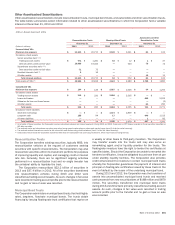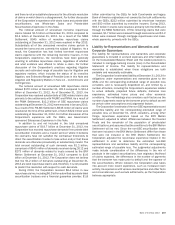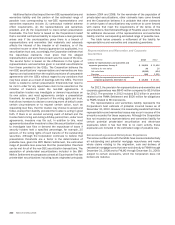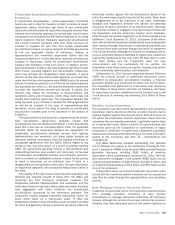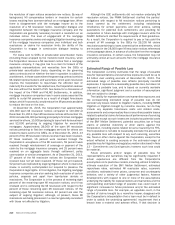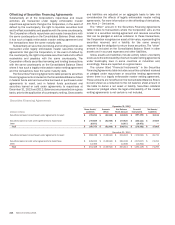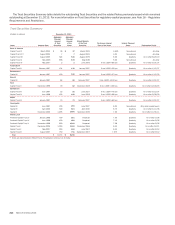Bank of America 2013 Annual Report Download - page 212
Download and view the complete annual report
Please find page 212 of the 2013 Bank of America annual report below. You can navigate through the pages in the report by either clicking on the pages listed below, or by using the keyword search tool below to find specific information within the annual report.210 Bank of America 2013
the resolution of open notices exceeded new notices. By way of
background, MI compensates lenders or investors for certain
losses resulting from borrower default on a mortgage loan. When
there is disagreement with the mortgage insurer as to the
resolution of a MI rescission notice, meaningful dialogue and
negotiation between the mortgage insurance company and the
Corporation are generally necessary to reach a resolution on an
individual notice. The level of engagement of the mortgage
insurance companies varies and ongoing litigation involving some
of the mortgage insurance companies over individual and bulk
rescissions or claims for rescission limits the ability of the
Corporation to engage in constructive dialogue leading to
resolution.
For loans sold to GSEs or private-label securitization trusts
(including those wrapped by the monoline bond insurers), when
the Corporation receives a MI rescission notice from a mortgage
insurance company, it may give rise to a claim for breach of the
applicable representations and warranties from the GSEs or
private-label securitization trusts, depending on the governing
sales contracts and on whether the loan in question is subject to
a settlement. In those cases where the governing contract contains
MI-related representations and warranties, which upon rescission
requires the Corporation to repurchase the affected loan or
indemnify the investor for the related loss, the Corporation realizes
the loss without the benefit of MI. See below for a discussion of
the impact of the FNMA and FHLMC Settlements. In addition,
mortgage insurance companies have in some cases asserted the
ability to curtail MI payments as a result of alleged foreclosure
delays, which if successful, would reduce the MI proceeds available
to reduce the loss on the loan.
At December 31, 2013, the Corporation had approximately
101,000 open MI rescission notices compared to 110,000 at
December 31, 2012. Open MI rescission notices at December 31,
2013 included 39,000 pertaining principally to first-lien mortgages
serviced for others, 10,000 pertaining to loans held-for-investment
and 52,000 pertaining to ongoing litigation for second-lien
mortgages. Approximately 28,000 of the open MI rescission
notices pertaining to first-lien mortgages serviced for others are
related to loans sold to the GSEs. As of December 31, 2013, 43
percent of the MI rescission notices received have been resolved.
Of those resolved, 16 percent were resolved through the
Corporation’s acceptance of the MI rescission, 59 percent were
resolved through reinstatement of coverage or payment of the
claim by the mortgage insurance company, and 25 percent were
resolved on an aggregate basis through settlement, policy
commutation or similar arrangement. As of December 31, 2013,
57 percent of the MI rescission notices the Corporation has
received have not yet been resolved. Of those not yet resolved,
52 percent are implicated by ongoing litigation where no loan-level
review is currently contemplated nor required to preserve the
Corporation’s legal rights. In this litigation, the litigating mortgage
insurance companies are also seeking bulk rescission of certain
policies, separate and apart from loan-by-loan denials or
rescissions. The Corporation is in the process of reviewing eight
percent of the remaining open MI rescission notices, and it has
reviewed and is contesting the MI rescission with respect to 92
percent of these remaining open MI rescission notices. Of the
remaining open MI rescission notices, 42 percent are also the
subject of ongoing litigation; although, at present, these MI
rescissions are being processed in a manner generally consistent
with those not affected by litigation.
Although the GSE settlements did not resolve underlying MI
rescission notices, the FNMA Settlement clarified the parties’
obligations with respect to MI rescission notices pertaining to
loans covered by the settlement, including establishing
timeframes for certain payments and other actions, setting
parameters for potential bulk settlements and providing for
cooperation in future dealings with mortgage insurers while the
FHLMC Settlement clarified the requirements of their guidelines.
As a result, the Corporation is required to pay or has paid the
amount of MI coverage to the GSEs for 26,200 MI claims
rescissions pertaining to loans covered by the settlements, which
are included in the 28,000 open MI rescission notices referenced
in the paragraph above, in advance of collection from the mortgage
insurance companies. In certain cases, the Corporation may not
ultimately collect all such amounts from the mortgage insurance
companies.
Estimated Range of Possible Loss
The Corporation currently estimates that the range of possible
loss for representations and warranties exposures could be up to
$4 billion over existing accruals at December 31, 2013. The
estimated range of possible loss reflects principally non-GSE
exposures. It represents a reasonably possible loss, but does not
represent a probable loss, and is based on currently available
information, significant judgment and a number of assumptions
that are subject to change.
The liability for representations and warranties exposures and
the corresponding estimated range of possible loss do not
consider any losses related to litigation matters, including RMBS
litigation or litigation brought by monoline insurers, nor do they
include any separate foreclosure costs and related costs,
assessments and compensatory fees or any other possible losses
related to potential claims for breaches of performance of servicing
obligations except as such losses are included as potential costs
of the BNY Mellon Settlement, potential securities law or fraud
claims or potential indemnity or other claims against the
Corporation, including claims related to loans insured by the FHA.
The Corporation is not able to reasonably estimate the amount of
any possible loss with respect to any such servicing, securities
law, fraud or other claims against the Corporation, except to the
extent reflected in existing accruals or the estimated range of
possible loss for litigation and regulatory matters disclosed in Note
12 – Commitments and Contingencies; however, such loss could
be material.
Future provisions and/or ranges of possible loss for
representations and warranties may be significantly impacted if
actual experiences are different from the Corporation’s
assumptions in its predictive models, including, without limitation,
ultimate resolution of the BNY Mellon Settlement, estimated
repurchase rates, estimated MI rescission rates, economic
conditions, estimated home prices, consumer and counterparty
behavior, and a variety of other judgmental factors. Adverse
developments with respect to one or more of the assumptions
underlying the liability for representations and warranties and the
corresponding estimated range of possible loss could result in
significant increases to future provisions and/or the estimated
range of possible loss. For example, an appellate court, in the
context of claims brought by a monoline insurer, disagreed with
the Corporation’s interpretation that a loan must be in default in
order to satisfy the underlying agreements’ requirement that a
breach have a material and adverse effect. If that decision is



